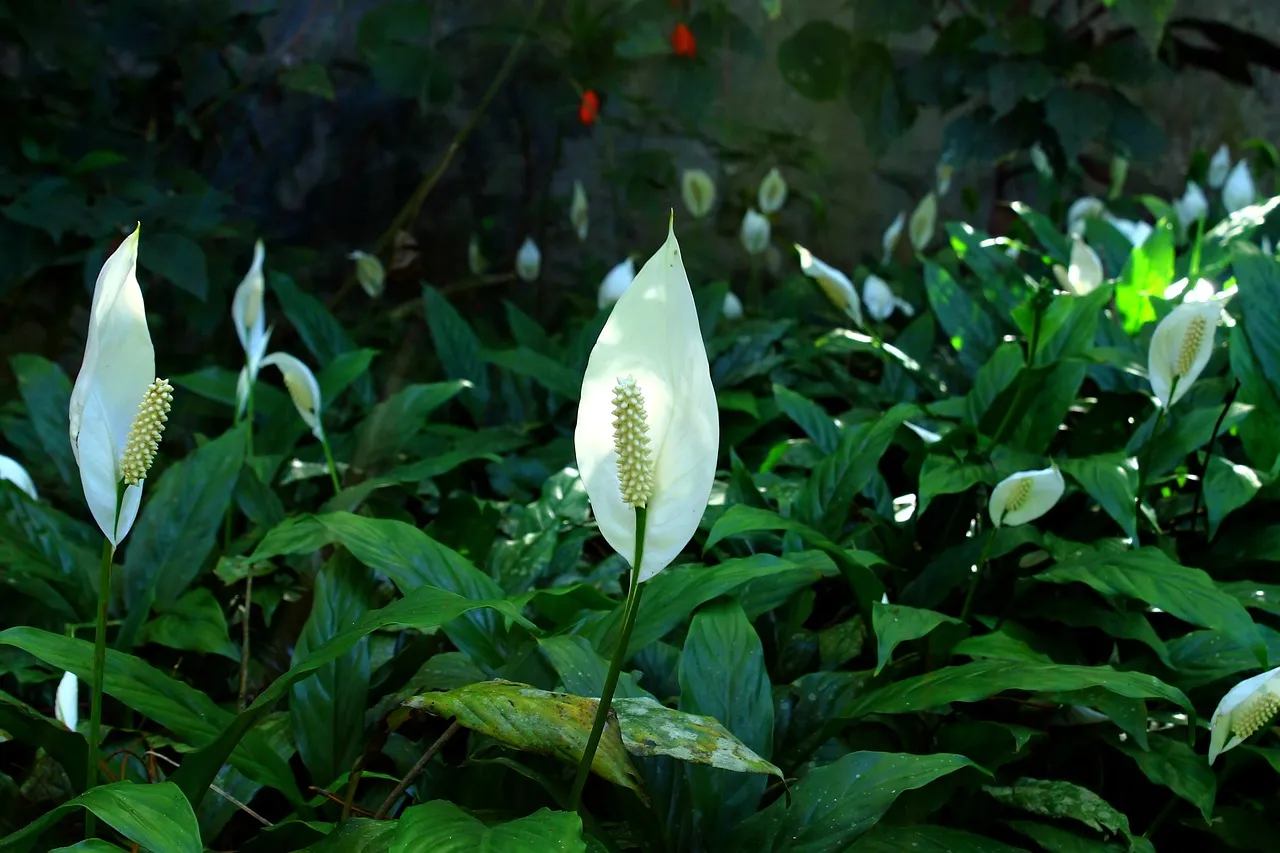Hi @eam-mt
Thanks for your question about your Peace Lillies (Spathiphyllum wallisii) leaves turning black.
The main reason why Peace Lillies turn black is over-watering. I know that you said you are not watering it too much but given you've only had it around two weeks its more than likely had too much care and attention!
I know it may sound bonkers, but nearly all house plants thrive when care and watering is given in frequently. Misting, feeding, repotting and moving plants around too much all cause distress to them and can cause black, yellow or crispy leaves.

My advice would be that repotting it and misting it has led to it being flooded with moisture. I would leave the Lily as it is and only water it once a week, and lay off the misting for now as well until it settles. It won't need any feed for a good month or two if you've repotted it too, so less of that too!
Cut off any completely black leaves right down to the base.
Understanding where Peace Lillies grow in the wild can help you work out what growing conditions they like.
Where do Peace Lillies come from?
Peace lilies (Spathiphyllum) are native to the tropical regions of the Americas, primarily found in Central and South America, as well as in the Caribbean. They are native to areas such as Colombia, Venezuela, and southeastern Brazil, where they grow in the understory of tropical rainforests.
In their natural habitat, peace lilies thrive in the dappled shade of tall trees, where they receive filtered sunlight and high humidity levels. They have been cultivated and introduced to many other regions around the world as popular ornamental houseplants due to their attractive foliage and elegant white flowers. By mimicking these conditions in the home you can happily keep Peace lillies as houseplants.
Below is also some more general advice on how to keep Peace Lily house plants to assist other Garden Ninja members!
How to look after Peace Lillies Properly
1.Light Levels
- Peace lilies prefer bright, indirect light. Avoid placing them in direct sunlight, as this can scorch their leaves. Opache windows (those with films or diffusers on them) or bathrooms are ideal to place Peace Lillies.
- They can tolerate lower light conditions but may not flower as profusely.
2. Watering Peace Lillies
- Avoid keeping the Peace Lily too wet. Whilst many guides claim they need to be moist all the time this isn't true.
- Water the plant once a week, no more.
- Avoid letting the plant sit in standing water, as this can lead to root rot and other issues.
3. Humidity
- Peace lilies thrive in high-humidity environments. Increase humidity levels by placing the plant on a pebble tray filled with water or using a humidifier. Alternatively, simply house them in bathrooms and high-humidity rooms of your house, like conservatories.
- Misting the leaves with water can help maintain humidity levels and prevent leaf browning, but it is not essential in most cases.
4. Temperature
- Maintain temperatures between 65°F and 80°F (18°C to 27°C). Peace lilies are sensitive to cold drafts and temperature extremes. So don;t place near doors or draughty windows.
- Protect them from cold air conditioning drafts or heating vents like radiators.
5. Fertilizing Peace Lillies
- Feed peace lilies with a balanced, water-soluble fertilizer diluted to half strength once a month during the growing season (spring and summer).
- Reduce fertilization to zero during the winter months when the plant's growth slows down.
https://youtu.be/5BhGtCjT2TQ
6. Pruning
- Remove dead or yellowing leaves with secateurs promptly to maintain the plant's appearance and prevent the spread of disease.
- Trim spent flowers to encourage new blooms and prevent the plant from diverting energy into seed production.
7. Repotting
- Repot peace lilies every 1-2 years or when they become root-bound. Choose a pot that is one size larger than the current container.
- Use a well-draining potting mix rich in organic matter that is a peat-free mix.
8. Pests and Diseases of Peace Lillies
- Monitor the plant regularly for signs of pests such as spider mites, fungus gnats, aphids, and mealybugs. Treat infestations promptly with insecticidal soap or neem oil.
- Watch for signs of root rot, which can occur due to overwatering or poor drainage. Adjust watering practices and ensure proper soil drainage.
9. Blooming
- Peace lilies typically bloom in spring and continue to flower intermittently throughout the year.
- Provide adequate light and proper care to encourage blooming.
I hope that helps and let us know how you get on!
Happy Gardening
Lee Garden Ninja
Hi @eam-mt
Thanks for your question about your Peace Lillies (Spathiphyllum wallisii) leaves turning black.
The main reason why Peace Lillies turn black is over-watering. I know that you said you are not watering it too much but given you've only had it around two weeks its more than likely had too much care and attention!
I know it may sound bonkers, but nearly all house plants thrive when care and watering is given in frequently. Misting, feeding, repotting and moving plants around too much all cause distress to them and can cause black, yellow or crispy leaves.

My advice would be that repotting it and misting it has led to it being flooded with moisture. I would leave the Lily as it is and only water it once a week, and lay off the misting for now as well until it settles. It won't need any feed for a good month or two if you've repotted it too, so less of that too!
Cut off any completely black leaves right down to the base.
Understanding where Peace Lillies grow in the wild can help you work out what growing conditions they like.
Where do Peace Lillies come from?
Peace lilies (Spathiphyllum) are native to the tropical regions of the Americas, primarily found in Central and South America, as well as in the Caribbean. They are native to areas such as Colombia, Venezuela, and southeastern Brazil, where they grow in the understory of tropical rainforests.
In their natural habitat, peace lilies thrive in the dappled shade of tall trees, where they receive filtered sunlight and high humidity levels. They have been cultivated and introduced to many other regions around the world as popular ornamental houseplants due to their attractive foliage and elegant white flowers. By mimicking these conditions in the home you can happily keep Peace lillies as houseplants.
Below is also some more general advice on how to keep Peace Lily house plants to assist other Garden Ninja members!
How to look after Peace Lillies Properly
1.Light Levels
- Peace lilies prefer bright, indirect light. Avoid placing them in direct sunlight, as this can scorch their leaves. Opache windows (those with films or diffusers on them) or bathrooms are ideal to place Peace Lillies.
- They can tolerate lower light conditions but may not flower as profusely.
2. Watering Peace Lillies
- Avoid keeping the Peace Lily too wet. Whilst many guides claim they need to be moist all the time this isn't true.
- Water the plant once a week, no more.
- Avoid letting the plant sit in standing water, as this can lead to root rot and other issues.
3. Humidity
- Peace lilies thrive in high-humidity environments. Increase humidity levels by placing the plant on a pebble tray filled with water or using a humidifier. Alternatively, simply house them in bathrooms and high-humidity rooms of your house, like conservatories.
- Misting the leaves with water can help maintain humidity levels and prevent leaf browning, but it is not essential in most cases.
4. Temperature
- Maintain temperatures between 65°F and 80°F (18°C to 27°C). Peace lilies are sensitive to cold drafts and temperature extremes. So don;t place near doors or draughty windows.
- Protect them from cold air conditioning drafts or heating vents like radiators.
5. Fertilizing Peace Lillies
- Feed peace lilies with a balanced, water-soluble fertilizer diluted to half strength once a month during the growing season (spring and summer).
- Reduce fertilization to zero during the winter months when the plant's growth slows down.
6. Pruning
- Remove dead or yellowing leaves with secateurs promptly to maintain the plant's appearance and prevent the spread of disease.
- Trim spent flowers to encourage new blooms and prevent the plant from diverting energy into seed production.
7. Repotting
- Repot peace lilies every 1-2 years or when they become root-bound. Choose a pot that is one size larger than the current container.
- Use a well-draining potting mix rich in organic matter that is a peat-free mix.
8. Pests and Diseases of Peace Lillies
- Monitor the plant regularly for signs of pests such as spider mites, fungus gnats, aphids, and mealybugs. Treat infestations promptly with insecticidal soap or neem oil.
- Watch for signs of root rot, which can occur due to overwatering or poor drainage. Adjust watering practices and ensure proper soil drainage.
9. Blooming
- Peace lilies typically bloom in spring and continue to flower intermittently throughout the year.
- Provide adequate light and proper care to encourage blooming.
I hope that helps and let us know how you get on!
Happy Gardening
Lee Garden Ninja
 Lee Burkhill: Award Winning Designer & BBC 1's Garden Rescue Presenters Official Blog
Lee Burkhill: Award Winning Designer & BBC 1's Garden Rescue Presenters Official Blog



